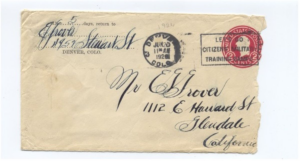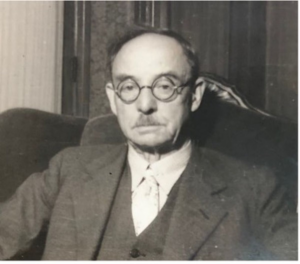I am nearly finished going through all the family pictures, papers, and heirlooms inherited from my parents. But, I wonder, will the task ever be truly finished?
Photos were the first to be sorted. Photos are relatively easy to catalogue, copy, and share, and they give us that glimpse of the ancestors we never knew. I do tend, however, to convince myself that I can glean more about the people in them than is justified. Can they truly reveal anything about a person’s character or personality? Was John Young as glum as he looks? Best not to guess.
 Letters were next to be tackled. Again, they are easy to copy, store, and share. A letter’s content can be quite revealing about the times and the writer, not to mention the genealogical information that letters frequently contain. And while handwriting in old letters can be difficult to interpret at times, I fear that handwriting will never be as good as it was in the past. Just as well: there will be few handwritten letters to inherit.
Letters were next to be tackled. Again, they are easy to copy, store, and share. A letter’s content can be quite revealing about the times and the writer, not to mention the genealogical information that letters frequently contain. And while handwriting in old letters can be difficult to interpret at times, I fear that handwriting will never be as good as it was in the past. Just as well: there will be few handwritten letters to inherit.
Then there are the various family possessions, keepsakes, and ephemera. Photographs of these items can be shared, but there is nothing like having and seeing the actual items. Some can be more difficult to deal with than others. What can be done with my great-grandfather’s writing desk or my great-great-great-grandmother’s rocking chair? Who next wants to take possession of them? There are no takers so far.
I am now dealing with a set of items that I have put off to the last – compact audio cassettes. There was a reason to put these off. They are the most difficult to deal with, and the least easy to share by the usual means. First you need a cassette player. (I still have one!) Next, you need to hook it up to a computer and find software that facilitates digital capturing and editing of the recordings.[1] Then there is the business of listening to hours of non-professional recordings to even find out what is there. Finally comes the difficult decision of what to keep and how best way to store and share audio clips: CDs or DVDs? Sorry, those are outmoded. Flash drives, hard drives, solid state drives? All will be gone before long, to be replaced by what?
These cassettes, of course, are not very old, but there are some family stories in them, and it is a pleasure to listen to familiar voices from the recent past. Naturally there can be genealogical information to be harvested – older people want to talk about the good old days.
In the meantime, I am listening to hours and hours of tape. I listened to two cassettes the other day just to find out that one is a duplicate of the other. I suspected as much, but had to listen to the end of both to be sure. So, keep just the best one. A few nice tidbits have emerged so far. One is my great-uncle talking about arriving by stagecoach in Hotchkiss, Colorado, when he was just four or five, circa 1904. Another is my father talking about being let out of high school to help local farmers pick potatoes. His job was to drive an old car in reverse in order to pull a wagon used to collect bagged potatoes from the fields. These cars had more power in reverse gear than in forward ones. What a pleasure to hear my father’s voice again.
To my delight, there is one recording that is a real gem.
To my delight, there is one recording that is a real gem. It is my Uncle Bill telling the story of his unplanned need to “ride the rails.” You really need to hear his voice to get the flavor, adventure, and humor in the story. But until Vita Brevis can share audio, you will have to make do with a short summary:
The year was 1934, and fall was in the air. The Depression was on; times were tough. Bill was eighteen and living with family in Tucson, Arizona. His sister had recently married a man from Kentucky and those two were now living in Harlan County, Kentucky. It wasn’t long before news came back to the family in Tucson that things in Wallins Creek were not going well. With his father having died, Bill was the one to travel back to Kentucky to investigate the situation. With some cash for gas and food, he set off for Kentucky in a well-used 1929 “Chevy.” This is a trip of about two thousand miles.
On his arrival, Bill discovered that his new brother-in-law was up to his ears in debt; the creditors were demanding payment and had become very threatening. The situation didn’t look good for his sister, so Bill used most of his money to buy a bus ticket for her to get back to Tucson. Why didn’t he just drive her back? The creditors concluded that since Bill was a relative of the debtor, his car would do nicely to pay off part of what they were owed. Legally or not, they took possession of his car and all it contained. Local authorities (likely relatives of the creditors) were disinclined to intervene. Bill was left with the clothes on his back and a dollar and fifty cents in his pocket. His problem now was how to get home. Plus, he had a seasonal job waiting for him that was to start in less than a month. He knew that in those Depression times his job would quickly be given to someone else if he did not show up in time.
Bill’s only option was to start walking west. And so he did for some time, walking through the hills and hollers of western Kentucky. Besides the difficulties of being on foot in unfamiliar territory, Bill felt the object of suspicion from everyone he met, some of them armed. These were difficult times, when any stranger in that area was suspected of being a “revenuer,” a government man looking for bootleggers. After some days of hitchhiking and walking, he arrived in a big town.
Pete was like many men of the time, roaming the country looking for work.
While wondering around looking for anything that offered hope, Bill met up with a fellow named Pete, last name forgotten. Pete was like many men of the time, roaming the country looking for work. Having heard Bill’s story, Pete said he was not going anywhere in particular and would happily join Bill in his journey west. But he was not going to walk – he would ride. Pete was a hobo,[2] and had developed a particular modus operandi suitable for the times. He wore overalls while hitching train rides, but in his travel bag he had a suit coat, pants, a nice shirt, shoe polish, and shaving gear. Arriving in a promising town, he would shave and polish his shoes, change into his nice clothes, and look for work. As a veteran of free travel, Pete was now going to show Bill how to “ride the rails.”
The first lesson was that to cover ground quickly, they would be particular about what kind of freight train to catch. If you hopped on the first one going by it could be a local, or worse, just one getting moved out of the way. So you wanted a long one, loaded up and going far. Look for a caboose – trains without a caboose were not going far. Next, you could not hop a train in the rail yard. The “bulls” (railroad police) would be sure to drag you off and teach you a lesson. You had to catch a train just outside the rail yard, where the train had not picked up too much speed, and where it was out of sight of the bulls.
The riding went pretty well for a while. But Bill did not have a real coat to keep warm in the now November nights. On the other hand, the freight cars could get quite hot during the day. They tried riding outside during one stretch of countryside, but they were too close to the front and were soon covered in coal soot. Food was problematic, but Pete knew his way around. Wearing his nice clothes, he could get something in most towns that the train stopped in. They took what they could get, and felt lucky when one time it was box of days-old cinnamon rolls.
As they got close to the Texas border, they were warned by others that it would be suicide to continue further. A bull had been killed by a tramp, and the word was that the bulls were out for blood. Local hobo camps were good places to learn such information. Also, there usually was someone in the camp who knew the destinations and schedules of the various trains coming and going. Bill and Pete were able to plan another route that took them northerly around Texas.
One night Bill, now without Pete, stopped at a hobo encampment for the night. It was very cold and the campfire at the hobo camp looked pretty inviting. Bill had been taught the proper etiquette for such situations. He had not helped collect wood nor built the fire, so he could only stand at the edge of the fire light. Soon, an old-timer came up and asked him if he would like to get warm by the fire. “Yes, sir,” was Bill’s reply. A little while later, he was asked if he wanted some coffee. “Yes, sir,” again. “Well, you will have to find your own cup. Over there are some old bean cans that will do.” Someone offered him some sugar. Bill found that the hobos were friendly and informative, but you needed to know their ways and needed to show respect.
Bill found that the hobos were friendly and informative, but you needed to know their ways and needed to show respect.
Bill made it back to Tucson just in time. On arrival and “reeking to the high heavens,” he made a partial clean-up in a public restroom before making his way home to family and food. A few days later he reported to work at his seasonal job at the El Conquistador Hotel in Tucson.[3]
At the end of the winter tourist season, when his job evaporated, Bill headed out for Estes Park, Colorado, where a summer job awaited him at the Stanley Hotel.[4] With earnings from his winter job, he had purchased another old car, but he didn’t have enough money for gas. Well, trains go north, too, and Bill, for the second and last time, rode the rails to get there. The summer went well for Bill. Also working at the Stanley was a lovely young woman (my mother’s sister), and Bill and she were married a few years later.
Bill had a final comment on riding the rails: “I wouldn’t do it again for anybody, but I wouldn’t take a million for missing that experience.”
Notes
[1] I am using Audacity, a free open-source program that has much capability. All such programs involve a learning curve.
[2] Hobos and tramps are sometimes thought of as one and the same. But there were distinctions. H.L. Mencken described them thus: “A hobo or bo is simply a migratory laborer; he may take some longish holidays, but soon or late he returns to work. A tramp never works if it can be avoided; he simply travels.” (The American Language, 4th ed. [New York: Alfred A. Knopf, 2006]), viewed online in Google Books. The original fourth edition was published in 1936, about the time of this story.
[3] The original El Conquistador went bankrupt in 1935; it had several owners until it was demolished in 1968. Tucson currently has a resort hotel by that name which was built in 1982.
[4] The Stanley Hotel was built in 1909 by Freelan Stanley, co-founder of the Stanley Motor Carriage Company, makers of steam-powered automobiles. The Stanley is still in operation and is listed in the National Register of Historic Places.
Share this:

About Philip Grover
Philip Grover is a retired chemical engineer who got involved in genealogy by helping his mother enter her extensive family research into Personal Ancestral File for Mac. Little did he know then what a slippery slope that minor involvement would become. After getting deeply involved in doing his own research, he realized how disinterested family members can be in genealogical charts, lists, and diagrams. His focus since has been making his family history more interesting and accessible, and toward that end he has self-published three books of family history.View all posts by Philip Grover →
